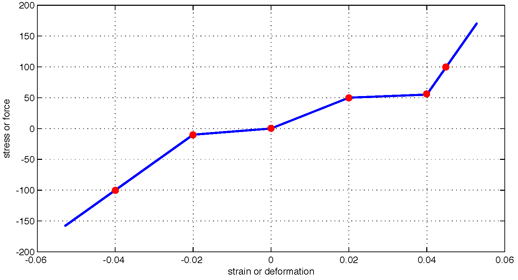Multi-Linear Velocity Dependent Friction: Difference between revisions
Jump to navigation
Jump to search
No edit summary |
No edit summary |
||
| Line 2: | Line 2: | ||
This command is used to construct a VelDepMultiLinear friction model object. | This command is used to construct a VelDepMultiLinear friction model object. | ||
The friction | The friction-velocity relationship is given by a multi-linear curve that is define by a set of points. | ||
The slope given by the last two specified points on the positive velocity axis is extrapolated to infinite positive velocities. | The slope given by the last two specified points on the positive velocity axis is extrapolated to infinite positive velocities. | ||
The number of provided velocity points needs to be equal to the number of provided friction points. | The number of provided velocity points needs to be equal to the number of provided friction points. | ||
Revision as of 22:39, 31 August 2012
- Command_Manual
- Tcl Commands
- Modeling_Commands
- model
- uniaxialMaterial
- ndMaterial
- frictionModel
- section
- geometricTransf
- element
- node
- sp commands
- mp commands
- timeSeries
- pattern
- mass
- block commands
- region
- rayleigh
- Analysis Commands
- Output Commands
- Misc Commands
- DataBase Commands
This command is used to construct a VelDepMultiLinear friction model object. The friction-velocity relationship is given by a multi-linear curve that is define by a set of points. The slope given by the last two specified points on the positive velocity axis is extrapolated to infinite positive velocities. The number of provided velocity points needs to be equal to the number of provided friction points.
| frictionModel VelDepMultiLinear $matTag -vel $velocityPoints -frn $frictionPoints |
| $frnTag | unique friction model object tag |
| $velocityPoints | array of velocity points along friction-velocity curve |
| $frictionPoints | array of friction points along friction-velocity curve |
EXAMPLE:
frictionModel VelDepMultiLinear 1 -vel 0.0 0.1 2.0 8.0 10.0 -frn 0.163 0.085 0.150 0.163 0.163
Code Developed by: Andreas Schellenberg, University of California, Berkeley.
